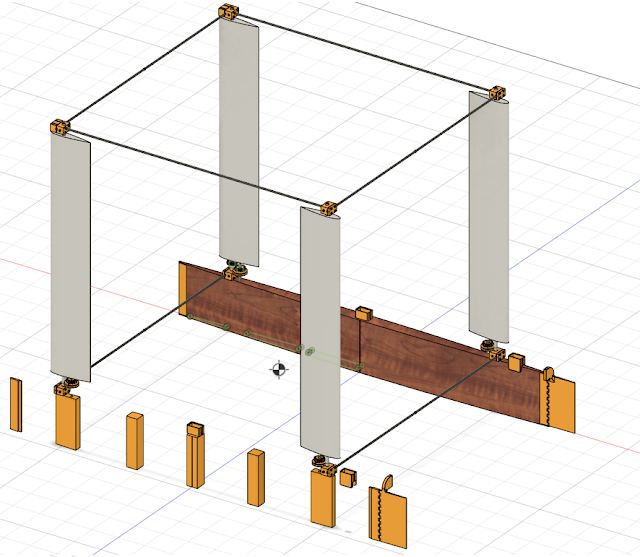The Cube - a driven wing sail catamaran sailing boat
The Cube
a driven wing sail catamaran sailing boat
Designs
Hears the cad models of the cube, a boat of my own design. There are two extremely thin hulls and 4 masts bearing 4 wing sails. Each wing sail can be independently operated but for the purpose of sailing that will move in unison. A very narrow transom holds some ever more slender rudders. The whole boat is built for speed. The sides of the hulls are completely vertical and the curves are just arks with a radius of about 15m. The hulls are 1.4m long and the rudders are 200mm long for a total water line length of 1.6m. Each hull has a full volume that is designed to displace a little more than the total mass of the boat. Theoretically, the boat could ride with one pontoon almost sunk and the other out of the water. This puts the water line just below halfway up the pontoons. "In theory"
Each wing is 900mm tall and has a cord of 150mm. A total wing area of 0.54 sqm. The wings are the naca 0018 shapes.
Construction
The hulls are made up of a series of printed blocks to form the shape of the hull. (printed to preserve the curve, turns out the printer sees a 15m ark over 30mm as a straight line) the blocks could have been made of wood if I was that handy with a table saw. The top and bottom of each pontoon are built of two layers of 3mm laser ply cut to the shape of the hulls. The blocks, the decks and the bow and stern parts all fit together so there's a 3mm rebate which a piece of 3mm hardboard fits into. This closes the volume. The two laser-cut layers of the decks are glued together with wood glue and then all the parts are glued together with polyester resin.
The hulls were painted with polyester gelcoat to waterproof them and it all so helps to make them look more boaty.
The boat was originally coated in gloss paint but that didn't work out well and had to be removed.
The wings were CNC hot weird out of expanded polystyrene and glued to aluminium tubes. They were then covered in gaffer tape to help with fairness and smoothness as the hot wire polystyrene is quite rough. The tubes have a gear which Is driven by a servo with a matching gear. When being assembled the wings can be dropped onto the frame and the gears aligned with a timing mark.
The frame is made of 8mm carbon fibre tubes and the joints are 3D-printed clamps.
20 kg servos operate all the wings and both rudders. The servos are driven by our custom control pcbs. (see electronics blog post for more info) Each servo has its own digital pin from the microcontroller so it can be trimmed individually. Then all the wing servos are linked together to operate the same and the time from the control input.
Once the carbon fibre tubes and hulls are all bolted together and the and the wings are put on, the boat is rigged to make the frame stiff. (the joints are quite loose and it's quite floppy without the rigging) a cross is formed on each face with two fixed loops and two loops adjusted by bowsie. A central cross is formed with a knot at the centre of the cube with 8 lines going to the 8 corners of the cube shape. These are all adjustable loops. When all the lines are tight the boat becomes quite stiff. The line is 50lb fishing line. It's a bit fiddly but it's quite thin but hopefully, it doesn't create much drag.
Sailing
We have taken it to our local boat club twice so far. using radio control as it currently does not have a wind vane but everything else it would need to sail itself.
The first time in a good breeze and it's tricky to set the wings but when you find the spot where they make a lot of lift it wizzes off. (technical sailing term)
The second time it was quite light air and the boat performs well with little wind.
Soon we plan to fit a wind vane and try some autonomously driven wing sailing and compare that to self-trimming wing sails
The boat sits a little lower in the water than planned but it's quite a win that it floats at all and that it sails so well. Under remote control, it can sail about 45° off the wind. It's possible it could point a bit higher with some more wind and the wings being controlled by computer








Comments
Post a Comment